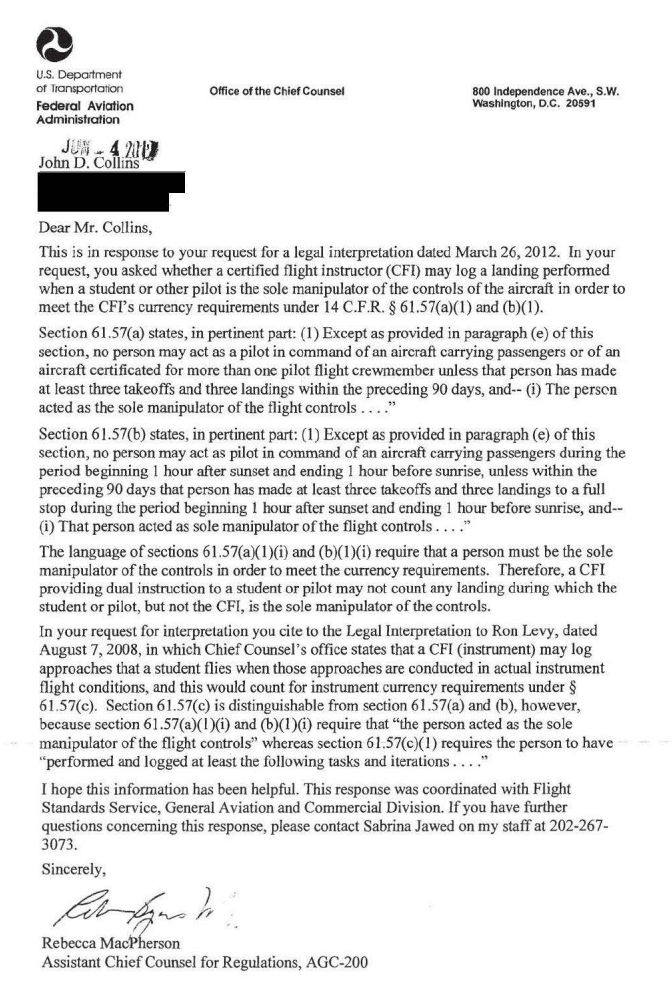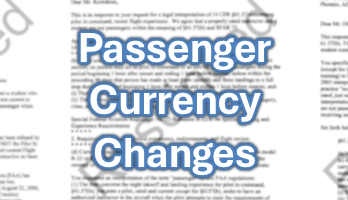Introduction
In a previous article (Instructor & Student Passenger Currency Changes), we discussed how recently rescinded letters of interpretation have led to the need for students and instructors to be passenger-current for training flights.
Good news—sort of! The FAA is making changes to passenger currency regulations that will partially revert to previous standards for instructional flights.
Effective December 2nd, 2024
Some things go back to normal, kinda…
New Passenger Currency Regulations Video
Don’t like reading? No problem – watch the video covering the new passenger currency regulation changes.
New Final Rule
First, I’d like to thank Sarah Deener of AOPA for pointing me to the upcoming regulatory changes. AOPA will publish an article on these changes in January; I will link to that article here. The FAA is making a series of regulatory changes effective December 2, 2024. You can see the full details of the new final rule, but the outline of changes includes:
- Logging Flight Time in Public Aircraft Operations (§ 61.51)
- Revision of the Definition of “Public Aircraft” (§ 1.1)
- Exceptions to Recent Flight Experience for Pilot in Command (§ 61.57(e))
- Flight Instructor Privileges (§§ 61.193 and 61.413)
- Flight Training is Carrying a Person for Compensation or Hire
- New Definition of Passenger (§ 61.1(b)) and Related Changes (§ 61.57)
- Experimental Light-Sport Aircraft (§ 91.319(e))
- Exception To Operating Certain Aircraft for the Purposes of Flight Training, Flightcrew Member Checking, or Flightcrew Member Testing (§ 91.326)
- Miscellaneous Issues in Part 91
The two sections relevant to this discussion are the changes to § 61.57 and § 61.1, which clarify and codify recent passenger-carrying currency requirements for flight instruction.
Rescinding & Rule Making
As discussed in the previous article (Instructor & Student Passenger Currency Changes) the FAA had previously issued letters of interpretation (Kortokrax 2006, Olshock 2007 & Schaffner 2014) stating that a pilot-in-training could fly with an instructor without either pilot meeting the passenger carrying currency of § 61.57 (a & b). The FAA then rescinded those letters, concluding that the “Legal Interpretation was based on the unsupported conclusion that a flight instructor and a person receiving flight training are not considered passengers to one another“… The FAA has now (December 2nd, 2024) changed the regulations to codify some of these situations. As AOPA noted in comments for the new rule, it is unfortunate that the FAA did not wait to rescind the letters until the regulations were changed…
The FAA notes that AOPA urged the FAA to reconsider its withdrawal of existing interpretations before the effective date of any final rule.
FAA Final Rule
New Passenger Definition
As part of the changes, the FAA has defined “Passenger” in § 61.1 as:
Passenger means any person on board an aircraft other than a crewmember, FAA personnel, manufacturer personnel required for type certification, or a person receiving or providing flight training, checking, or testing as authorized by this part.
§ 61.1 Applicability and Definitions
So a student and instructor are officially not considered passengers to each other. However, the flight recency requirement of §61.57 has now changed “passenger” to “person” ensuring there is still a requirement, but with exceptions for a certain situations…
Passenger Currency Now Person Currency
Although I use the phrase “passenger-current” throughout this article, that is not technically the correct now. With the the new definition of “passenger”, the FAA is also updating the day and night “passenger currency” to “person currency” – so that it applies to any person onboard, not just those defined as passengers.
…no person may act as a pilot in command of an aircraft carrying passengers…
OLD 61.57 Passenger Currency
…no person may act as a pilot in command of an aircraft carrying persons…
NEW 61.57 Person Currency
The New Exception
As mentioned, a new exception to to passenger/person carrying requirements for instructional flights has been added to §61.57(e) Exceptions:
(5) Paragraphs (a) and (b) of this section do not apply to a person receiving flight training from an authorized instructor, provided:
(i) The flight training is limited to the purpose of meeting the requirements of paragraphs (a) and (b) of this section;
(ii) Notwithstanding the provisions of paragraphs (a) and (b) of this section, the person receiving flight training meets all other requirements to act as pilot in command of the aircraft; and
(iii) The authorized instructor and the person receiving flight training are the sole occupants of the aircraft.
Conditions for the Exception
The exception only applies if the following conditions are met:
- The purpose of the flight is limited to the pilot-in-training to get current under § 61.57 (a or b)
- The pilot meets all other requirements to act PIC (they must be rated in that aircraft, for example)
- The instructor and pilot-in-training are the only persons on board (no other students in the backseat, for instance)
Good for the Pilot-In-Training, Not So for the Instructor
This exception allows a pilot-in-training who is rated in the aircraft but not person-current to take a flight with an instructor to get current (even if the instructor is also not person-current!). However, if the pilot-in-training is not otherwise qualified to act as PIC in that aircraft (like a new student pilot or add-on student), then the instructor must be person-current. The FAA makes a distinction between these situations, citing a difference in risk:
Although this final rule is enabling a situation where a flight instructor may be on board an aircraft with another pilot, neither of whom has met the recent flight experience requirements, the risk is mitigated by the fact that both persons are otherwise qualified to operate the aircraft.
FAA Final Rule
If the same flight instructor were to act as PIC of an aircraft carrying a flight student who is not an otherwise qualified pilot, the risk is increased because, in the event of an emergency, only one person is capable of operating the aircraft, rather than two, and the sole person capable of operating does not have the benefit of recent flight experience (in other words, certain proficiencies may have degraded over time due to disuse).
Sole Manipulator of the Flight Controls
The person acted as the sole manipulator of the flight controls…
Logging takeoff and landings per § 61.57
It remains critical for instructors to accurately log their takeoff and landings, but only when they were are “sole manipulator of the flight controls“. Instructors can log cross-country time, night time and even instrument time (if in actual IMC) while instructing and not on the controls. However, the regulations (§ 61.57) and a letter of interpretation (Collins, 2014) clarify that the instructor must be the “sole manipulator of the flight controls” to log takeoff and landing for person-currency.
SFAR 73 Person Currency
If you train or instruct in an Robinson R22 or R44, despite the SFAR 73 recent big changes, you still must be model-specific person-current in the R22 to act as PIC in the R22 and person-current in the R44 to act PIC in the R44.

So, make sure as an instructor you are regularly demonstrating and logging your day and night landings, especially in the R22 & R44.
Scenarios to Consider
Consider the following scenarios for a night flight (at least 1 hour past sunset) in a Robinson R44 (so SFAR 73 currency requirements apply). Assess if each scenario conforms to the new person carrying requirement. Click the question text to reveal the answer for each, based on my person interpretation of the new rules.
Scenario 1
The pilot-in-training is a private pilot (helicopter) with an SFAR 73 endorsement to act PIC in the R44, but the instructor is not night person-current in the R44. The flight involves some night takeoff and landings to get the pilot-in-training night person-current.
Click this text for the answer.
Yes, this flight meets the requirements, because the pilot-in-training is otherwise qualified to act PIC in the R44 and the purpose of the flight is to get the pilot-in-training night person-current.
Scenario 2
Same as scenario 1, but with another student in the back, who is actively learning by watching and listening.
Click this text for the answer.
No, because the new 61.57 exception for flight training, requires no other person can be onboard, except the instructor and pilot-in-training.
Scenario 3
Same as scenario 1 except the plan is just to fly a long night cross-country to relocate the helicopter for a tour the following morning.
Click this text for the answer.
No, probably, because under the new 61.57 exception for flight training, the purpose of the flight is supposed to be limited to getting the pilot-in-training person-current. Perhaps if you did the required night landings and takeoffs during that flight, you might be able to argue the point, and perhaps that will be the question in a future letter of interpretation….
Scenario 4
The pilot-in-training is a private pilot (helicopter) but is new to the R44 and does not yet have an SFAR 73 endorsement to act PIC in the R44. The instructor is not night person-current in the R44. The flight will involve some night takeoff and landings to get the pilot-in-training night person-current.
Click this text for the answer.
No, because the pilot-in-training is not otherwise qualified to act PIC in the R44 and so the instructor would need to be night person-current in the R44.
DISCLAIMER – make sure you are fully informed on the latest regulations and their application.
For official guidance on laws and regulations, refer to your Certified Flight Instructor (CFI) or local Flight Standards District Office (FSDO) . Helicopter Training Videos aims to promote aviation knowledge and safety but makes no guarantees regarding accuracy or legal applications.
Feedback
What do you think of these regulation changes? Do you interpret any of this differently? Let us know using the comments form below:






